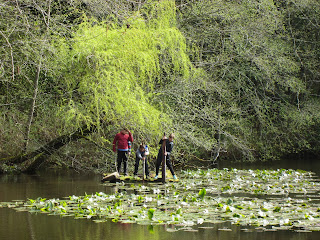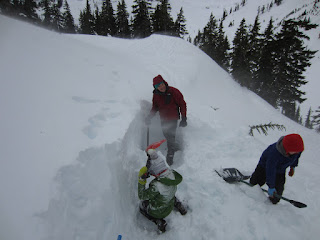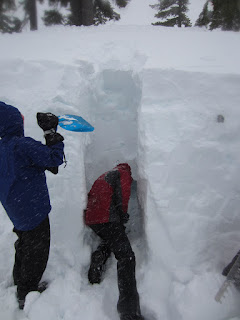The Alevin Explorers met on 24 Street for what would be
their last exploration style outing as a group.
Although it might not seem significant to someone who doesn’t know the
Alevin’s history, this outing location marks the beginning of their seven-year
journey in the Boys Explorers Club. Here the group would circle back to where
they began, to reflect on their experience, and to reconnect with their roots.
Sitting down for an open circle in the Hundred Acre Wood the
mentors let the group know that the day’s outing was for them. The two things
we would hold to as leaders was that we took time for a sit spot and that group
made a strong plan for the day.
Going around the circle the Tribal Elder facilitated a quick and easy decision. The Alevin
decided to head over to Hoag’s Pond to check out a make shift raft that one of
the boys found a few weeks earlier, and then they would figure out the rest
along the way.
Hiking along the trail the boys were quite nostalgic, sharing
memories of their explorations and giving each other some guff for their
mishaps and self-imposed hardships. Finding the raft tied-up on the
Northeastern corner of the pond, a few brave Explorers grabbed the best paddle
stick they could find and stepped out on faith aboard the vessel. The raft was
composed primarily of 2x4’s and plywood that encased Styrofoam blocks for
floatation.
The group quickly found that a few corners of the raft were
not stable. The scene looked straight out of the Adventures of Huckleberry
Finn as they paddled out through the lilies to middle of the pond. A few
Canada Geese angrily called out at the Explorers as they paddled by.
Simultaneously one of the Explorers wrestled the paddles out of another boy’s
hand, trying to sabotage the crew by stranding them without a means of
locomotion. This plan seemed counterintuitive as he was also aboard the ship.
Some things for these rascally Alevin never change!
Miraculously none of crew fell off and they made it safely
to shore with only wet feet. Circling up next to the pond we ate lunch in the
sunshine and watched a Kingfisher buzz about the lake scoring some quick snacks
in the Pond Lilies. One Explorer commented as he pulled a bag of Cheetos out of
his lunch, “Did you know you can use these a fire starter?”. This led to a series
of experiments lighting Doritos and Cheetos aflame. The experiment digressed
into one Explorer trying to roast an apple over the flames and another trying
to jokingly smoke a hollow-tubed pretzel stick. He took one puff and quickly
let out a plum of smoke, coughing from the fumes. Mentors quickly put an end to
the silliness and asked the Explorers what was next on the docket.
Circling up the Explorers made another fluid decision and
decided to head back over to the Hundred Acre Wood for a few rounds of Spider’s Web. Hiking the trail back over
it was clear to see that the group had gleaned much naturalist knowledge during
their time in the program. With spring in full bloom we looked spotted a few of
our favorite plants and blossoms: Vanilla Leaf, Big Leaf Maple buds, Trillium
flowers, and Red Flowering Currant to name a few. What a pleasure it was to
venture through the forest in the company of these elder Explorers.
Under the shade of Cedars and Grand Fir the boys set up the
game course on a steep hillside and really got into the power of play. We snuck
and crawled through the under brush, laughed at our lack of awareness as we fell
victim to the spider, and rejoiced in the moment circling up sweaty and satisfied
for a Sit Spot.
The Explorers were prompted to reflect on their time in the
program and distill their experience into their major takeaways. Brian told the
group that his Grandson would soon be beginning his journey in the BEC and that
he wanted to know what essential elements of the Alevin’s journey his grandson
would need to have to get the full Explorers Club experience.
Spreading out over the landscape the group was quiet and
still. Glorious sunshine and a gentle breeze blew through forest while
Black-Capped Chickadees foraged through the upper canopy; the moment was
perfect and serene.
Circling back up the Explorers shared their takeaways:
·
Play
Spiders Web and Hide (engaging in
free play and games in the natural world)
·
Have Chances
to Stretch their Edge (provide opportunities for personal empowerment
through group challenges and big wilderness)
·
Opportunity
for Engagement (service at Connelly Creek and EMA’ing with the younger
Explorers)
·
Sit Spot
(personal connection with the landscape, time spent immersed in the natural
world, present, processing, reflection)
·
The Opportunity
to Roast Apples (learning Earth skills and becoming proficient wilderness
travelers)
·
Circle
Time and Working Together as a Group (learning how to be part of a
community, inter/intrapersonal dynamics, group facilitation, leadership, being genuine,
honest, speaking one’s truths)
After sharing their thoughts we sliced apples and shared our
thanks. It was then that a few of the boys started to loose focus and talked
over one another. With a stern voice the mentors called for their attention,
reminding the group that life is a dance between the sacred and the profane,
and that there are moments for both. Time spent in circle is sacred; sharing
together openly, honestly, genuinely, and being present.
Refocusing the group made a strong close to their day. Our
outing on all accounts had been a pure exploration in the Explorer Club sense.
What a wonderful way for the Explorers to grieve the loss of their group as
Alevin and their transition into the Four Shields or whatever else lies ahead
for them this summer and beyond!
Parents we are headed out on a campout for the Alevin’s last
Explorers Club outing. We will be headed up to Lizard Lake and this
trip will look much more like a mini-backpack than the normal car based
campouts that the group has been accustom to. Please make sure your Explorer
reviews the overnight
packing list and let us know if they are missing any gear. We have lots of
backpacking style packs and gear at the office that they are welcome to borrow.
For more pictures from the outing please visit the Alevin’s photo album from the day.

















